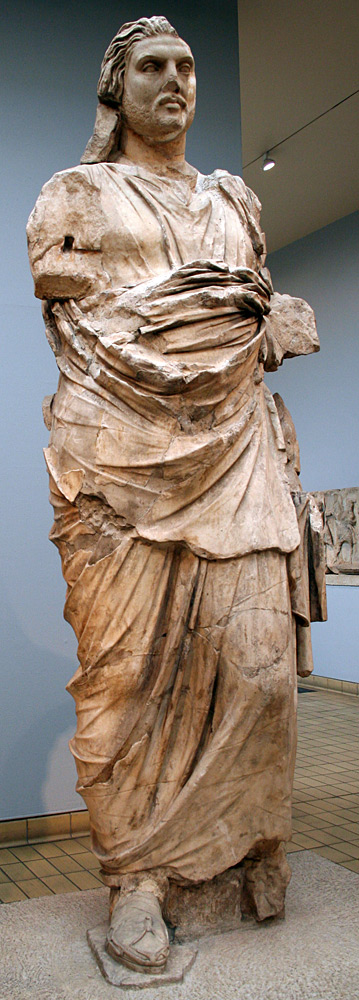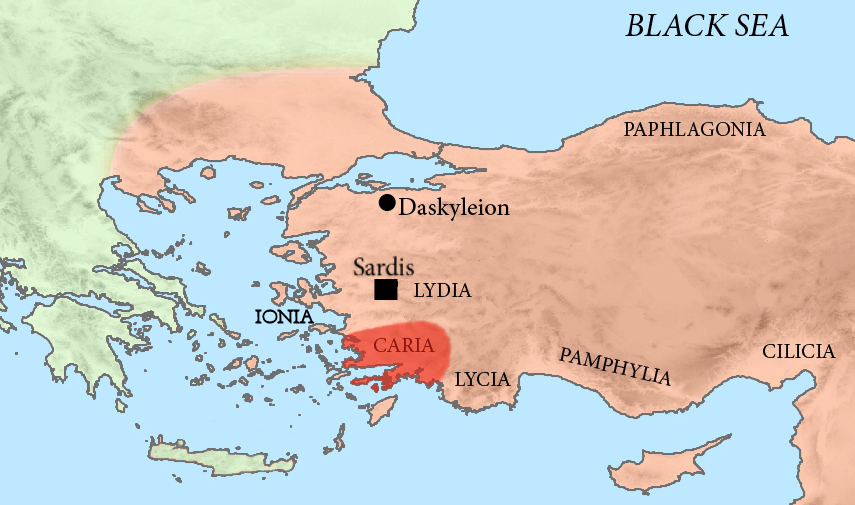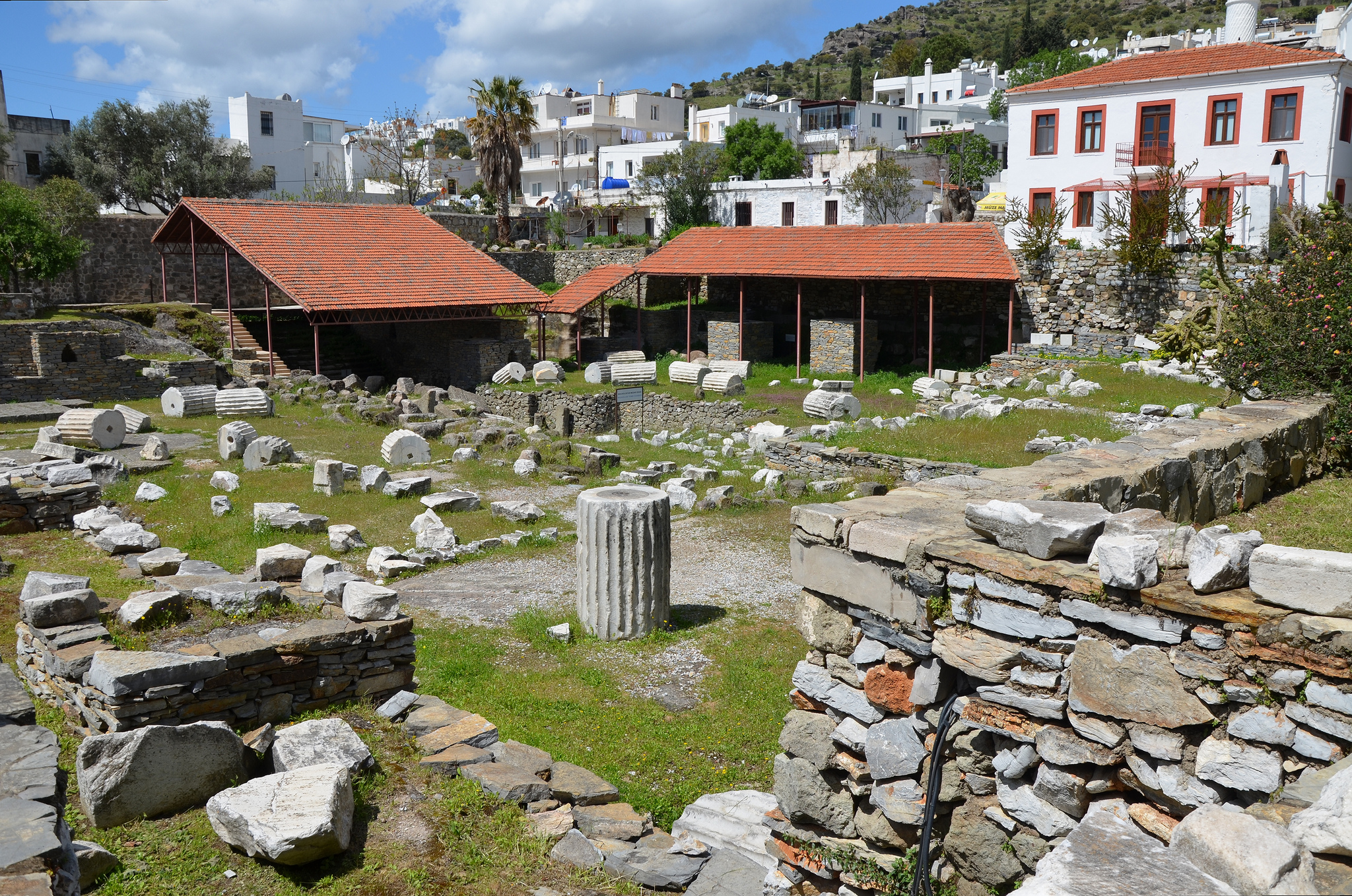|
Hecatomnid
The Hecatomnid dynasty or Hecatomnids were the rulers of Caria and surrounding areas BCE. The Hecatomnids were satraps (governors) under the Achaemenid Empire, although they ruled with considerable autonomy, and established a hereditary dynasty. The first satrap of the dynasty was Hecatomnus. He was appointed as the first Carian satrap of Caria in the late 390s BCE. Previously, Caria had been governed as part of Lydia, by the satrap Tissaphernes based in Sardis. Tissaphernes was executed by Tithraustes on the orders of Artaxerxes II Memnon in 395 BCE. If Hecatomnus did not become satrap immediately upon the death of Tissaphernes, he was in office by 392 BCE, when he made war on Evagoras of Salamis on the orders of Artaxerxes II Memnon. Hecatomnus therefore became satrap of Caria BCE. He was previously one of many minor dynasts in Caria. The Hecatomnid dynasty's seat was originally Mylasa, in central Caria. Hecatomnus' father, Hyssaldomus, was also an independent dynast based ... [...More Info...] [...Related Items...] OR: [Wikipedia] [Google] [Baidu] |
Hecatomnus
Hecatomnus of Mylasa or Hekatomnos ( el, Ἑκατόμνος, Carian: 𐊴𐊭𐊪𐊵𐊫 ''k̂tmno'' “under-son, descendant(?)”) was an early 4th-century BC ruler of Caria. He was the satrap (governor) of Caria for the Persian Achaemenid king Artaxerxes II (404–358 BC). However, the basis for Hecatomnus' political power was twofold: he was both a high appointed Persian official and a powerful local dynast, who founded the hereditary dynasty of the Hecatomnids. The Hecatomnids followed the earlier autochthonous dynasty of the Lygdamids (520-450 BC) in Caria. Biography Hecatomnus was the son and successor of Hyssaldomus, a dynastic ruler of Mylasa. It is likely that Hecatomnus had been a supporter of Tissaphernes and might have been employed by him in the subordinate office of hyparch. At some time after 395 BC Hecatomnus became the first satrap of Caria, which was until then part of other satrapies, usually that of Lydia. The designation of Caria as a separate satr ... [...More Info...] [...Related Items...] OR: [Wikipedia] [Google] [Baidu] |
Mausolus
Mausolus ( grc, Μαύσωλος or , xcr, ���𐊠���𐊸𐊫𐊦 ''Mauśoλ'') was a ruler of Caria (377–353 BCE) and a satrap of the Achaemenid Empire. He enjoyed the status of king or dynast by virtue of the powerful position created by his father Hecatomnus ( xcr, 𐊴𐊭𐊪𐊳𐊫 ), who had succeeded the assassinated Persian Satrap Tissaphernes as the first satrap of Caria and founded the hereditary Hecatomnid dynasty. Alongside Caria, Mausolus also ruled Lycia and parts of Ionia and the Dodecanese islands. He is best known for the monumental shrine, the Mausoleum at Halicarnassus, erected and named for him by order of his widow (who was also his sister) Artemisia. Name Mausolus' name is only known directly in Greek ( grc, Μαύσωλος or ). It is clearly of Carian origin, though, and would have been written as *𐊪𐊠𐊲𐊸𐊫𐊦 (''*Mauśoλ'') or similar. This is a compound name perhaps meaning "much blessed". The first part, ''*Ma-'', may mean "much ... [...More Info...] [...Related Items...] OR: [Wikipedia] [Google] [Baidu] |
Ada Of Caria
Ada of Caria ( grc, Ἄδα) ( fl. 377 – 326 BC)377 BC is the date of her father's death: was a member of the House of Hecatomnus (the Hecatomnids) and ruler of Caria during the mid-4th century BC, first as Persian Satrap and later as Queen under the auspices of Alexander III (the Great) of Macedon. History Ada was the daughter of Hecatomnus, satrap of Caria, sister of Mausolus, Pixodarus, Artemisia, and Idrieus.Sears, Matthew A. (2014). p.213 Four of the siblings intermarried: Mausolus wed Artemisia, while Ada was married to her brother Idrieus. Pixodarus married outside of the family. Every child of Hecatomnus would govern over Caria at some point. Mausolus and Artemisia first ruled together, and after Mausolus' death, Artemisia ruled alone until she died in 344 BC. Idrieus and Ada ruled together for four years, until his death. During their rule, they kept close ties to the Hellenic world.Sears, Matthew A. (2014). p.217 The joint regents were mentioned as donors to the ... [...More Info...] [...Related Items...] OR: [Wikipedia] [Google] [Baidu] |
Artemisia II Of Caria
Artemisia II of Caria (Ancient Greek, Greek: Ἀρτεμισία; died 350 BC) was a naval strategist, commander and Sibling marriage#Sibling marriage and incest, the sister (and later spouse) and the successor of Mausolus, ruler of Caria. Mausolus was a satrap of the Achaemenid Empire, yet enjoyed the status of king or dynast of the Hecatomnid dynasty. After the death of her brother/husband, Artemisia reigned for two years, from 353 to 351 BCE. Her ascension to the throne prompted a revolt in some of the island and coastal cities under her command due to their objection to a female ruler. Her administration was conducted on the same principles as that of her husband; in particular, she supported the Oligarchy, oligarchical party on the island of Rhodes. Because of Artemisia's grief for her brother-husband, and the extravagant and bizarre forms it took, she became to later ages "a lasting example of chaste widowhood and of the purest and rarest kind of love", in the words of ... [...More Info...] [...Related Items...] OR: [Wikipedia] [Google] [Baidu] |
Pixodarus
Pixodarus or Pixodaros (in Lycian 𐊓𐊆𐊜𐊁𐊅𐊀𐊕𐊀 ''Pixedara''; in Greek Πιξώδαρoς; ruled 340–334 BC), was a satrap of Caria, nominally the Achaemenid Empire Satrap, who enjoyed the status of king or dynast by virtue of the powerful position his predecessors of the House of Hecatomnus (the Hecatomnids) created when they succeeded the assassinated Persian Satrap Tissaphernes in the Carian satrapy. Lycia was also ruled by the Carian dynasts since the time of Mausolus, and the name of Pixodarus as ruler appears in the Xanthos trilingual inscription in Lycia. Biography He was the youngest of the three sons of Hecatomnus, all of whom held the sovereignty of their native country. Pixodarus obtained possession of the throne by the expulsion of his sister Ada, the widow of their brother Idrieus, with whom she had jointly governed Caria. He ruled Caria without opposition for a period of four years, 340–334 BC. He cultivated the friendship with Persia, givi ... [...More Info...] [...Related Items...] OR: [Wikipedia] [Google] [Baidu] |
Idrieus
Idrieus, or Hidrieus ( grc, Ἱδριεύς, Hidrieús; died 344 BC) was a ruler of Caria as a Satrap under the Achaemenid Empire. Alongside his sister and wife Ada, he enjoyed the status of king or dynast by virtue of the powerful position he inherited from his predecessors of the House of Hecatomnus (the Hecatomnids). Biography Idrieus was the second son of Hecatomnus, and was married to his sister Ada. Alongside Ada, he succeeded to the throne on the death of his sister Artemisia II of Caria in 351 BC. Shortly after his accession he was required by the Persian king, Artaxerxes III Ochus, to provide arms and troops for the capture of Cyprus, a request with which he readily complied. He equipped a fleet of 40 triremes and assembled an army of 8000 mercenary troops. These were despatched for use against Cyprus under the command of Evagoras and the Athenian general Phocion. This is the only recorded event preserved from his reign. However; it can be inferred from Isocrates th ... [...More Info...] [...Related Items...] OR: [Wikipedia] [Google] [Baidu] |
Pixodarus Of Caria
Pixodarus or Pixodaros (in Lycian 𐊓𐊆𐊜𐊁𐊅𐊀𐊕𐊀 ''Pixedara''; in Greek Πιξώδαρoς; ruled 340–334 BC), was a satrap of Caria, nominally the Achaemenid Empire Satrap, who enjoyed the status of king or dynast by virtue of the powerful position his predecessors of the House of Hecatomnus (the Hecatomnids) created when they succeeded the assassinated Persian Satrap Tissaphernes in the Carian satrapy. Lycia was also ruled by the Carian dynasts since the time of Mausolus, and the name of Pixodarus as ruler appears in the Xanthos trilingual inscription in Lycia. Biography He was the youngest of the three sons of Hecatomnus, all of whom held the sovereignty of their native country. Pixodarus obtained possession of the throne by the expulsion of his sister Ada, the widow of their brother Idrieus, with whom she had jointly governed Caria. He ruled Caria without opposition for a period of four years, 340–334 BC. He cultivated the friendship with Persia, giving ... [...More Info...] [...Related Items...] OR: [Wikipedia] [Google] [Baidu] |
Mylasa
Milas ( grc, Μύλασα, Mylasa) is an ancient city and the seat of the district of the same name in Muğla Province in southwestern Turkey. The city commands a region with an active economy and very rich in history and ancient remains, the territory of Milas containing a remarkable twenty-seven archaeological sites of note. The city was the first capital of ancient Caria and of the Anatolian beylik of Menteşe in mediaeval times. The nearby Mausoleum of Hecatomnus is classified as a tentative UNESCO World Heritage Site. Milas is focused on agricultural and aquacultural processing, related industrial activities, services, transportation (particularly since the opening of Milas–Bodrum Airport), tourism and culture. The centre lies about 20 km from the coast and is closer to the airport than Bodrum itself, with many late arrival passengers of the high season increasingly opting to stay in Milas rather than in Bodrum where accommodation is likely to be difficult to find. ... [...More Info...] [...Related Items...] OR: [Wikipedia] [Google] [Baidu] |
Lygdamid Dynasty
The Lygdamid dynasty ( BCE) was a dynasty of tyrants in the region of Caria, who were subordinate to the Achaemenid Empire following the conquests of Cyrus the Great through his general Harpagus. The dynasty was founded by Lygdamis, of Carian-Greek ethnicity. The dynasty issued several tyrants, until the last one, Lygdamis II, died , after which Halicarnassus joined the Athenian alliance, known as the Delian League. At that time, Halicarnassus started to appear on the Athenian tribute quota lists. From 395 BCE, Caria would again fall under the control of the Achaemenid Empire and be ruled by a new dynasty of local tyrants, the Hecatomnids. Rulers * Lygdamis I ( BCE) *Artemisia Artemisia may refer to: People * Artemisia I of Caria (fl. 480 BC), queen of Halicarnassus under the First Persian Empire, naval commander during the second Persian invasion of Greece * Artemisia II of Caria (died 350 BC), queen of Caria under th ... ( BCE) * Pisindelis ( BCE) * Lygdamis II ( BCE) ... [...More Info...] [...Related Items...] OR: [Wikipedia] [Google] [Baidu] |
Mausoleum At Halicarnassus
The Mausoleum at Halicarnassus or Tomb of Mausolus ( grc, Μαυσωλεῖον τῆς Ἁλικαρνασσοῦ; tr, Halikarnas Mozolesi) was a tomb built between 353 and 350 BC in Halicarnassus (present Bodrum, Turkey) for Mausolus, an Anatolian from Caria and a satrap in the Achaemenid Empire, and his sister-wife Artemisia II of Caria. The structure was designed by the Greek architects Satyros and Pythius of Priene. Its elevated tomb structure is derived from the tombs of neighbouring Lycia, a territory Mausolus had invaded and annexed c. 360 BC, such as the Nereid Monument. The Mausoleum was approximately in height, and the four sides were adorned with sculptural reliefs, each created by one of four Greek sculptors: Leochares, Bryaxis, Scopas of Paros, and Timotheus. The mausoleum was considered to be such an aesthetic triumph that Antipater of Sidon identified it as one of his Seven Wonders of the Ancient World. It was destroyed by successive earthquakes from the 1 ... [...More Info...] [...Related Items...] OR: [Wikipedia] [Google] [Baidu] |
Carian Language
The Carian language is an extinct language of the Luwic subgroup of the Anatolian branch of the Indo-European language family. The Carian language was spoken in Caria, a region of western Anatolia between the ancient regions of Lycia and Lydia, by the Carians, a name possibly first mentioned in Hittite sources. Carian is closely related to Lycian and Milyan (Lycian B), and both are closely related to, though not direct descendants of, Luwian. Whether the correspondences between Luwian, Carian, and Lycian are due to direct descent (i.e. a language family as represented by a tree-model), or are due to the effects of a sprachbund, is disputed. Sources Carian is known from these sources: * Nearly 40 inscriptions from Caria including five Carian-Greek bilinguals (however, only for two of them the connection between the Carian and Greek text is evident) * Two inscriptions from mainland Greece: a bilingual from Athens and a graffito from Thessaloniki * 60 funeral inscriptions of the ... [...More Info...] [...Related Items...] OR: [Wikipedia] [Google] [Baidu] |
Alexander The Great
Alexander III of Macedon ( grc, wikt:Ἀλέξανδρος, Ἀλέξανδρος, Alexandros; 20/21 July 356 BC – 10/11 June 323 BC), commonly known as Alexander the Great, was a king of the Ancient Greece, ancient Greek kingdom of Macedonia (ancient kingdom), Macedon. He succeeded his father Philip II of Macedon, Philip II to the throne in 336 BC at the age of 20, and spent most of his ruling years conducting a lengthy military campaign throughout Western Asia and ancient Egypt, Egypt. By the age of thirty, he had created one of the List of largest empires, largest empires in history, stretching from Greece to northwestern Historical India, India. He was undefeated in battle and is widely considered to be one of history's greatest and most successful military commanders. Until the age of 16, Alexander was tutored by Aristotle. In 335 BC, shortly after his assumption of kingship over Macedon, he Alexander's Balkan campaign, campaigned in the Balkans and reasserted control ... [...More Info...] [...Related Items...] OR: [Wikipedia] [Google] [Baidu] |


.jpg)





